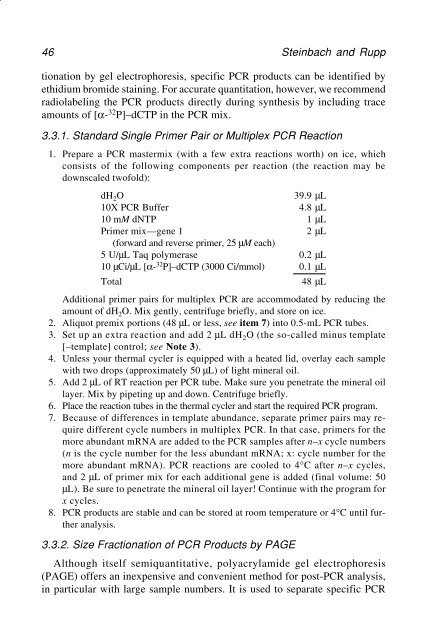Molecular Methods in Developmental Biology Molecular Methods in ...
Molecular Methods in Developmental Biology Molecular Methods in ...
Molecular Methods in Developmental Biology Molecular Methods in ...
- No tags were found...
You also want an ePaper? Increase the reach of your titles
YUMPU automatically turns print PDFs into web optimized ePapers that Google loves.
46 Ste<strong>in</strong>bach and Rupptionation by gel electrophoresis, specific PCR products can be identified byethidium bromide sta<strong>in</strong><strong>in</strong>g. For accurate quantitation, however, we recommendradiolabel<strong>in</strong>g the PCR products directly dur<strong>in</strong>g synthesis by <strong>in</strong>clud<strong>in</strong>g traceamounts of [α- 32 P]–dCTP <strong>in</strong> the PCR mix.3.3.1. Standard S<strong>in</strong>gle Primer Pair or Multiplex PCR Reaction1. Prepare a PCR mastermix (with a few extra reactions worth) on ice, whichconsists of the follow<strong>in</strong>g components per reaction (the reaction may bedownscaled twofold):dH 2 O 39.9 µL10X PCR Buffer 4.8 µL10 mM dNTP 1 µLPrimer mix—gene 1 2 µL(forward and reverse primer, 25 µM each)5 U/µL Taq polymerase 0.2 µL10 µCi/µL [α- 32 P]–dCTP (3000 Ci/mmol) 0.1 µLTotal 48 µLAdditional primer pairs for multiplex PCR are accommodated by reduc<strong>in</strong>g theamount of dH 2 O. Mix gently, centrifuge briefly, and store on ice.2. Aliquot premix portions (48 µL or less, see item 7) <strong>in</strong>to 0.5-mL PCR tubes.3. Set up an extra reaction and add 2 µL dH 2 O (the so-called m<strong>in</strong>us template[–template] control; see Note 3).4. Unless your thermal cycler is equipped with a heated lid, overlay each samplewith two drops (approximately 50 µL) of light m<strong>in</strong>eral oil.5. Add 2 µL of RT reaction per PCR tube. Make sure you penetrate the m<strong>in</strong>eral oillayer. Mix by pipet<strong>in</strong>g up and down. Centrifuge briefly.6. Place the reaction tubes <strong>in</strong> the thermal cycler and start the required PCR program.7. Because of differences <strong>in</strong> template abundance, separate primer pairs may requiredifferent cycle numbers <strong>in</strong> multiplex PCR. In that case, primers for themore abundant mRNA are added to the PCR samples after n–x cycle numbers(n is the cycle number for the less abundant mRNA; x: cycle number for themore abundant mRNA). PCR reactions are cooled to 4°C after n–x cycles,and 2 µL of primer mix for each additional gene is added (f<strong>in</strong>al volume: 50µL). Be sure to penetrate the m<strong>in</strong>eral oil layer! Cont<strong>in</strong>ue with the program forx cycles.8. PCR products are stable and can be stored at room temperature or 4°C until furtheranalysis.3.3.2. Size Fractionation of PCR Products by PAGEAlthough itself semiquantitative, polyacrylamide gel electrophoresis(PAGE) offers an <strong>in</strong>expensive and convenient method for post-PCR analysis,<strong>in</strong> particular with large sample numbers. It is used to separate specific PCR












